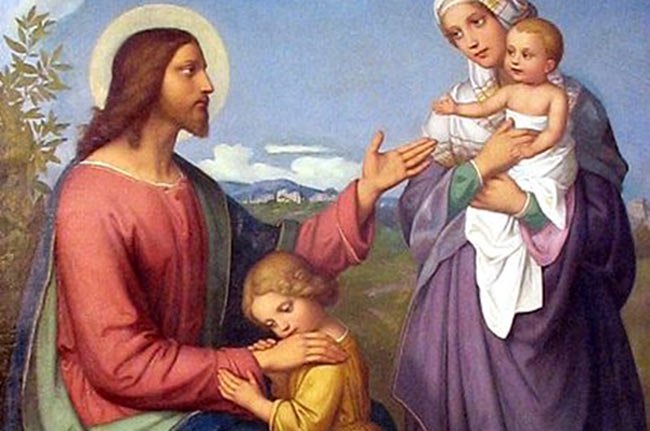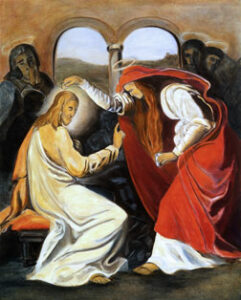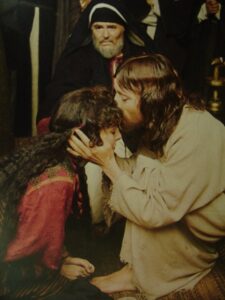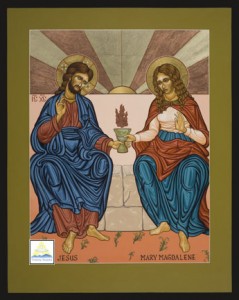Authors Joan Norton, Margaret Starbird and Burl Hall and the rest of us were discussing Martin Luther and the Sacred Feminine on our GoddessChristians forum. Â Margaret wrote in as follows:
Among other strange opinions of Martin Luther, I stumbled into a quote of his from “Table Talks” to the effect that Jesus had affairs with three women: the women at the well, the woman taken in adultery, and Mary Magdalene. I found this really interesting because it appears to me to be a “garbled” reference to Cathar beliefs that Mary Magdalene, the woman at the well, and the woman taken in adultery were all the same person (one woman–not three)…. But Luther was suggesting that Jesus had promiscuous relationships with all three! Pretty bizarre behavior, in my view!–in a time and place where people had strong taboos about promiscuity and were stoned for less….and from a rabbi who warned that to think lustfully about a woman was tantamount to committing “adultery in one’s heart.”
> VATICAN CITY (Reuters) – In the latest Vatican broadside against
> “The Da Vinci Code,” a leading cardinal says Christians should
> respond to the book and film with legal action because both offend
> Christ and the Church he founded.
Since Dan Brown derived his basic ideas about Mary Magdalene and Jesus from my “Woman with the Alabaster Jar,” I would like to say that when I wrote that book I was coming from the heart of the Roman Catholic Church and a charismatic prayer group that included two priests and six lay people to which I had belonged for about 15 years at the time.Â
These people were encouraging me and praying for me while I was doing my research because we had been shown as a community that there was something important missing from the foundations of Christianity that had to do with the “denigrated Feminine.”
I gave my “Alabaster Jar” manuscript to my Roman Catholic priest/pastor–and to two Protestant ministers in 1991- before I ever dreamed of sending it to a publisher. All three of these clergymen knew me well and encouraged me to publish my book. In fact, the Catholic priest told me, “This could heal the Church.” I offered “Alabaster Jar” as a gift to the Church–one that would enable the patriarchy to embrace the “Feminine” embodied in Mary Magdalene and welcome her home with rejoicing! What a shame that they cannot see the healing that would inevitably flow from the “nuptials of the Lamb and his Bride.”
Carl Jung states in “Answer to Job” that it is incongruous to visualize Jesus embracing a church filled with people. He needs to embrace a woman… This image is beautifully expressed in the stained glass window from the Kilmore Church at Dervaig, a town on the Isle of Mull, (posted on my website) which shows Jesus and Mary “hand-fasted” (clasping right hands)–a symbol for marriage in the Christian liturgy…the “Bride” represents her land and people–as in the ancient metaphor of Yahweh’s undying love for his people….
There was never any intent to attack Jesus…. I was trying to “heal the wasteland” that ensues when the “Feminine” principle is denied and defamed, forced into exile and silenced….
In the triptych above the inner door at Mary Magdalene’s basilica at Vézeley, France, (the “Madeleine”), the left hand of Jesus is missing-probably vandalized, although it may have just broken off. What an incredible reminder that he can’t be “whole” without her! Since Judaism in the first century didn’t have a word for “bachelor” –and the word the Jews now use is “ravak”–“empty”–maybe we need to revisit the foundations of the Christian faith and restore the “lost Bride.”
peace and light,
Margaret
“Mary Magdalene, Bride in Exile”
http://www.margaretstarbird.net
Â
Joan Norton, author of Mary Magdalene Within, responded:
   Hi Margaret,
  I wonder if Martin Luther’s interpretation of the three women as Jesus’ “involvements” influenced Joseph Smith’s Mormon revelations that Jesus had more than one wife? I know they put the ritual of the bridal chamber at the center of things, but with the extra added twist of more than one wife.
   I put up a new podcast meditation today called “Beloveds in the Garden” at http://marymagdalenewithin.podomatic.com  and I don’t mean Jesus and three Beloveds! (chuckle)
 xoJoan
* * * * * * * * * * * * * * * * * * * * * * * * *
And author Burl Hall wrote in with the following intriguing thoughts:
You say it all, Margaret. In my work, I have come to the opinion that the wasteland we have created in the environment (endless wars, ecological destruction, sensationalist medias, etc.) is a mirror to the wasteland of our minds. I talk somewhat of the surface level ego mind, or empirical/rational thought as surface level with deep thought, the Feminine, lying underneath. By underneath I don’t mean this as a power relationship. Indeed, Tehom, the Depths of Genesis 1:2, is Feminine and is the foundations of the Universe and ultimately the Mother of Light (Manifestation). Furthermore, it is She that becomes this world. As the Hindu Ramakrishna puts it, “The Unmanifest (Being…Tehom…Brahman….Yahweh…Marie…Tao) shines forth as Shakti (the Goddess, Divine Energy, Sophia)…and Shakti takes form as this entire universe.”
Sometimes when I close my eyes I watch images dance in my mind. They tend to shapeshift and will often play with me as if I were an external being. They are so much fun. And, they appear aware of me as much as I am aware of them. … When I watch these images dance (they do indeed have a life of their own that is beyond my controlling ego) I realize they are the creation of something deeper…furthermore, I realize that the power within me that is creating this wonderful display is not separate from that Power that births, supports and dissolves the cosmos. To “see” that Power, I go behind the images and into the Darkness, the Darkness upon the face of the Deep. (Mary or Marie also means Ocean as per the terms Marine, Marina, etc.).
So, when Sophia (the Agent of Becoming, the Holy Spirit) came upon Tehom as the Holy Spirit in Genesis and the Holy Spirit moved upon Marie in the New Testament, are we perhaps repeating the same story? “The Unmanifest (Marie) shines forth as Shakti (Sophia) and Shakti is simply the luminous darkness of the Unmanifest,” Ramakrishna says. Or as Paul McCarney says, “When I find myself in times of trouble, Mother Mary comes to me. Speaking words of Wisdom, Let It Be.” Mary and Sophia are akin to water and wetness, they are not two. McCartney may not have been consciously aware of this….but, hey, Sophia speaks beneath the ego. Anyhow, the way I see this relation of Mary the Magdeline (She of the Temple Towers is a definition?) as Wife and Mary the Virgin as Mother. These are not, from a non-historical perspective, two Women. From a mystical dimension, the birth from Marie is reflective of Motherhood of Woman while the Fate function of Woman is reflected in the Magdeline as Wife or Bride. I look at this as the Goddess as Mother and the Goddess as Fate. One is birth from Woman, the Unmanifest, the other is the return Home, to the Unmanifest. Women in their physical bodies mirror this cosmic power of birth, maintanence and fate or dissolution.
This too speaks of Jung with his notion of the Feminine as the Unconscious. I do not see the Feminine as Unconscious as much as suppressed. When I think of Sophia, I think of Her in my body and think, “Now I don’t know how my heart is beating or how fast, yet She is in my body monitoring all of this and through a complicated system of communications is making changes.” This same intelligence is worldwide and, indeed, universe wide. Earth is an integrated system every bit as much as our body. Furthermore, the surface level intelligence doesn’t know how to listen (which manifest in the words of many women who say that men don’t know how to listen…this is true for how we relate to women AND our inner worlds, which are suppressed at worst or at best turned into media propaganda (e.g., advertising…this is one reason we have created a wasteland).
Suppressing the Feminine externally is the suppression of the Feminine internally. I recall as a child how many artists, true artists, were ridiculed as being effeminite. Why? Because they are able to tap into the wild, unruly and surprisingly rebellious or evolutionary Feminine Intelligence. Deep Femininty is a danger to the status quo for She is the agent of change. As the Book of Wisdom says, “She renews the world.” All things change and transform in accordance to Sophia. This is why the Feminine scares us. It means dissolution of the old and the birth of the new.Â
Anyway, you probably weren’t looking for all of this in a response.  Its the prozac! Thanks for your post and your work.
–Burl
* * * * * * * * * * * * * * * * *
I posted some thoughts about the Vatican saying Magdalene and Jesus being married is an insult, a blasphemy against Christianity and that Christians should rise up and riot, bring lawsuits, etc. against those who believe these harmless (and inspiring, if you ask me) things. Â I wrote:
Yeah, notice how they are quick to say Christ and the “Church he founded” have been gravely insulted by the suggestion he may have been a full man with a woman and kids in his life yet, yet, YET, they do nothing when those horrible paintings of someone urinating on the crucified Jesus, or defecating on him or Mary are displayed prominently in famous NY (and other city) art galleries. That is one reason to call a “Christian Fatwa” if you ask me and is similar in theory (altho not degree!) to the Mohammed cartoons. Just imagine if urine and feces had been done to Mohammed. They freaked when the pages of a copy of the Koran might have been used as toilet paper when Muslims (and others) burn Torahs, Bibles and flags all the time.
Don’t get me started…. but rock on Margaret for tellin’ ’em like it is — the Church needs the “denigrated Feminine” RESTORED and it ain’t an insult to nobody, least of all Jesus/Yeshua.
Katia
Â



